[English] 日本語
 Yorodumi
Yorodumi- EMDB-20129: Bacillus halodurans Cas4-Cas1-Cas2 symmetrical complex in presenc... -
+ Open data
Open data
- Basic information
Basic information
| Entry | Database: EMDB / ID: EMD-20129 | |||||||||
|---|---|---|---|---|---|---|---|---|---|---|
| Title | Bacillus halodurans Cas4-Cas1-Cas2 symmetrical complex in presence of target CRISPR DNA | |||||||||
 Map data Map data | Bacillus halodurans Cas4-Cas1-Cas2 symmetrical complex with target CRISPR hairpin DNA | |||||||||
 Sample Sample |
| |||||||||
| Biological species |  Bacillus halodurans C-125 (bacteria) Bacillus halodurans C-125 (bacteria) | |||||||||
| Method | single particle reconstruction / negative staining / Resolution: 19.7 Å | |||||||||
 Authors Authors | Sashital DG / Lee H / Dhingra Y | |||||||||
 Citation Citation |  Journal: Elife / Year: 2019 Journal: Elife / Year: 2019Title: The Cas4-Cas1-Cas2 complex mediates precise prespacer processing during CRISPR adaptation. Authors: Hayun Lee / Yukti Dhingra / Dipali G Sashital /  Abstract: CRISPR adaptation immunizes bacteria and archaea against viruses. During adaptation, the Cas1-Cas2 complex integrates fragments of invader DNA as spacers in the CRISPR array. Recently, an additional ...CRISPR adaptation immunizes bacteria and archaea against viruses. During adaptation, the Cas1-Cas2 complex integrates fragments of invader DNA as spacers in the CRISPR array. Recently, an additional protein Cas4 has been implicated in selection and processing of prespacer substrates for Cas1-Cas2, although this mechanism remains unclear. We show that Cas4 interacts directly with Cas1-Cas2 forming a Cas4-Cas1-Cas2 complex that captures and processes prespacers prior to integration. Structural analysis of the Cas4-Cas1-Cas2 complex reveals two copies of Cas4 that closely interact with the two integrase active sites of Cas1, suggesting a mechanism for substrate handoff following processing. We also find that the Cas4-Cas1-Cas2 complex processes single-stranded DNA provided in cis or in trans with a double-stranded DNA duplex. Cas4 cleaves precisely upstream of PAM sequences, ensuring the acquisition of functional spacers. Our results explain how Cas4 cleavage coordinates with Cas1-Cas2 integration and defines the exact cleavage sites and specificity of Cas4. | |||||||||
| History |
|
- Structure visualization
Structure visualization
| Movie |
 Movie viewer Movie viewer |
|---|---|
| Structure viewer | EM map:  SurfView SurfView Molmil Molmil Jmol/JSmol Jmol/JSmol |
| Supplemental images |
- Downloads & links
Downloads & links
-EMDB archive
| Map data |  emd_20129.map.gz emd_20129.map.gz | 1.7 MB |  EMDB map data format EMDB map data format | |
|---|---|---|---|---|
| Header (meta data) |  emd-20129-v30.xml emd-20129-v30.xml emd-20129.xml emd-20129.xml | 15.7 KB 15.7 KB | Display Display |  EMDB header EMDB header |
| Images |  emd_20129.png emd_20129.png | 49.8 KB | ||
| Archive directory |  http://ftp.pdbj.org/pub/emdb/structures/EMD-20129 http://ftp.pdbj.org/pub/emdb/structures/EMD-20129 ftp://ftp.pdbj.org/pub/emdb/structures/EMD-20129 ftp://ftp.pdbj.org/pub/emdb/structures/EMD-20129 | HTTPS FTP |
-Validation report
| Summary document |  emd_20129_validation.pdf.gz emd_20129_validation.pdf.gz | 77.9 KB | Display |  EMDB validaton report EMDB validaton report |
|---|---|---|---|---|
| Full document |  emd_20129_full_validation.pdf.gz emd_20129_full_validation.pdf.gz | 77 KB | Display | |
| Data in XML |  emd_20129_validation.xml.gz emd_20129_validation.xml.gz | 494 B | Display | |
| Arichive directory |  https://ftp.pdbj.org/pub/emdb/validation_reports/EMD-20129 https://ftp.pdbj.org/pub/emdb/validation_reports/EMD-20129 ftp://ftp.pdbj.org/pub/emdb/validation_reports/EMD-20129 ftp://ftp.pdbj.org/pub/emdb/validation_reports/EMD-20129 | HTTPS FTP |
-Related structure data
| Related structure data | C: citing same article ( |
|---|---|
| Similar structure data |
- Links
Links
| EMDB pages |  EMDB (EBI/PDBe) / EMDB (EBI/PDBe) /  EMDataResource EMDataResource |
|---|
- Map
Map
| File |  Download / File: emd_20129.map.gz / Format: CCP4 / Size: 2 MB / Type: IMAGE STORED AS FLOATING POINT NUMBER (4 BYTES) Download / File: emd_20129.map.gz / Format: CCP4 / Size: 2 MB / Type: IMAGE STORED AS FLOATING POINT NUMBER (4 BYTES) | ||||||||||||||||||||||||||||||||||||||||||||||||||||||||||||
|---|---|---|---|---|---|---|---|---|---|---|---|---|---|---|---|---|---|---|---|---|---|---|---|---|---|---|---|---|---|---|---|---|---|---|---|---|---|---|---|---|---|---|---|---|---|---|---|---|---|---|---|---|---|---|---|---|---|---|---|---|---|
| Annotation | Bacillus halodurans Cas4-Cas1-Cas2 symmetrical complex with target CRISPR hairpin DNA | ||||||||||||||||||||||||||||||||||||||||||||||||||||||||||||
| Projections & slices | Image control
Images are generated by Spider. | ||||||||||||||||||||||||||||||||||||||||||||||||||||||||||||
| Voxel size | X=Y=Z: 3.8 Å | ||||||||||||||||||||||||||||||||||||||||||||||||||||||||||||
| Density |
| ||||||||||||||||||||||||||||||||||||||||||||||||||||||||||||
| Symmetry | Space group: 1 | ||||||||||||||||||||||||||||||||||||||||||||||||||||||||||||
| Details | EMDB XML:
CCP4 map header:
| ||||||||||||||||||||||||||||||||||||||||||||||||||||||||||||
-Supplemental data
- Sample components
Sample components
-Entire : Bacillus halodurans Cas4-Cas1-Cas2 symmetrical complex with targe...
| Entire | Name: Bacillus halodurans Cas4-Cas1-Cas2 symmetrical complex with target CRISPR hairpin DNA |
|---|---|
| Components |
|
-Supramolecule #1: Bacillus halodurans Cas4-Cas1-Cas2 symmetrical complex with targe...
| Supramolecule | Name: Bacillus halodurans Cas4-Cas1-Cas2 symmetrical complex with target CRISPR hairpin DNA type: organelle_or_cellular_component / ID: 1 / Parent: 0 / Macromolecule list: all |
|---|---|
| Source (natural) | Organism:  Bacillus halodurans C-125 (bacteria) Bacillus halodurans C-125 (bacteria) |
| Molecular weight | Experimental: 280 KDa |
-Macromolecule #1: Cas1
| Macromolecule | Name: Cas1 / type: protein_or_peptide / ID: 1 / Enantiomer: LEVO |
|---|---|
| Source (natural) | Organism:  Bacillus halodurans C-125 (bacteria) Bacillus halodurans C-125 (bacteria) |
| Recombinant expression | Organism:  |
| Sequence | String: MKKLLNTLYV TQPDTYLSLD GDNVVLLKEQ EKLGRLPLHN LEAIVGFGYT GASPALMGYC AERNISITF LTKNGRFLAR VVGESRGNVV LRKTQYRISE NDQESTKIAR NFITGKVYNS K WMLERMTR EHPLRVNVEQ FKATSQLLSV MMQEIRNCDS LESLRGWEGQ ...String: MKKLLNTLYV TQPDTYLSLD GDNVVLLKEQ EKLGRLPLHN LEAIVGFGYT GASPALMGYC AERNISITF LTKNGRFLAR VVGESRGNVV LRKTQYRISE NDQESTKIAR NFITGKVYNS K WMLERMTR EHPLRVNVEQ FKATSQLLSV MMQEIRNCDS LESLRGWEGQ AAINYNKVFD QM ILQQKEE FAFHGRSRRP PKDNVNAMLS FAYTLLANDV AAALETVGLD AYVGFMHQDR PGR ASLALD LMEELRGLYA DRFVLSLINR KEMTADGFYK KENGAVLMTD EARKTFLKAW QTKK QEKIT HPYLGEKMSW GLVPYVQALL LARFLRGDLD EYPPFLWK |
-Macromolecule #2: Cas2
| Macromolecule | Name: Cas2 / type: protein_or_peptide / ID: 2 / Enantiomer: LEVO |
|---|---|
| Source (natural) | Organism:  Bacillus halodurans C-125 (bacteria) Bacillus halodurans C-125 (bacteria) |
| Recombinant expression | Organism:  |
| Sequence | String: MLVLITYDVQ TSSMGGTKRL RKVAKACQNY GQRVQNSVFE CIVDSTQLTS LKLELTSLID EEKDSLRIY RLGNNYKTKV EHIGAKPSID LEDPLIF |
-Macromolecule #3: Cas4
| Macromolecule | Name: Cas4 / type: protein_or_peptide / ID: 3 / Enantiomer: LEVO |
|---|---|
| Source (natural) | Organism:  Bacillus halodurans C-125 (bacteria) Bacillus halodurans C-125 (bacteria) |
| Recombinant expression | Organism:  |
| Sequence | String: MASNEEDRYL MLSGLQHFQF CKRQWALIHI EQQWEENVRT IEGQHLHKKA DQPFMKEKRG SKLTVRAMPI QSKNLQISGI CDVVEFVQDS EGIELSGVSG SYKAFPVEYK RGKPKKGDED IVQLVAQAMC LEEMLVCRID KGYLFYNEIK HRVEVPITDA LRDKVVQMAK ...String: MASNEEDRYL MLSGLQHFQF CKRQWALIHI EQQWEENVRT IEGQHLHKKA DQPFMKEKRG SKLTVRAMPI QSKNLQISGI CDVVEFVQDS EGIELSGVSG SYKAFPVEYK RGKPKKGDED IVQLVAQAMC LEEMLVCRID KGYLFYNEIK HRVEVPITDA LRDKVVQMAK EMHHYYENRH TPKVKTGPFC NNCSLQSICL PKLMNKRSVK RYIEGRLSE |
-Macromolecule #4: target CRISPR hairpin DNA
| Macromolecule | Name: target CRISPR hairpin DNA / type: dna / ID: 4 / Classification: DNA |
|---|---|
| Source (natural) | Organism:  Bacillus halodurans C-125 (bacteria) Bacillus halodurans C-125 (bacteria) |
| Sequence | String: GATTTTCGCT GTCGCACTCT TCATGGGTGC GTGGATTGAA ATATTGACGA TAGTCAATAT TTCAATCCAC GCACCCATGA AGAGTGCGAC AGCGAAAATC |
-Experimental details
-Structure determination
| Method | negative staining |
|---|---|
 Processing Processing | single particle reconstruction |
| Aggregation state | particle |
- Sample preparation
Sample preparation
| Concentration | 0.028 mg/mL | ||||||||||||||||||
|---|---|---|---|---|---|---|---|---|---|---|---|---|---|---|---|---|---|---|---|
| Buffer | pH: 7.5 Component:
| ||||||||||||||||||
| Staining | Type: NEGATIVE / Material: uranyl formate Details: 3 uL of sample was applied to a glow-discharged copper 400-mesh continuous carbon grid for one minute at room temperature. The excess sample was blotted with Whatman filter paper, followed ...Details: 3 uL of sample was applied to a glow-discharged copper 400-mesh continuous carbon grid for one minute at room temperature. The excess sample was blotted with Whatman filter paper, followed by immediate application of 3 uL 2% (w/v) uranyl formate. The excess stain was blotted, followed by immediate application of 3 uL 2% uranyl formate. This step was repeated once more. The grids were allowed to dry for at least 5 minutes prior to imaging. | ||||||||||||||||||
| Grid | Support film - Material: CARBON / Support film - topology: CONTINUOUS / Details: unspecified |
- Electron microscopy
Electron microscopy
| Microscope | JEOL 2100 |
|---|---|
| Image recording | Film or detector model: GATAN ULTRASCAN 4000 (4k x 4k) / Digitization - Dimensions - Width: 4096 pixel / Digitization - Dimensions - Height: 4096 pixel / Number grids imaged: 1 / Number real images: 200 / Average exposure time: 0.5 sec. / Average electron dose: 30.0 e/Å2 |
| Electron beam | Acceleration voltage: 200 kV / Electron source: LAB6 |
| Electron optics | Illumination mode: FLOOD BEAM / Imaging mode: BRIGHT FIELD |
 Movie
Movie Controller
Controller


 UCSF Chimera
UCSF Chimera




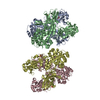
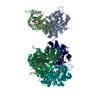
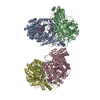
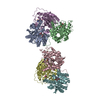

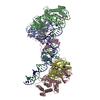
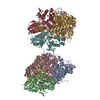
 Z (Sec.)
Z (Sec.) Y (Row.)
Y (Row.) X (Col.)
X (Col.)






















